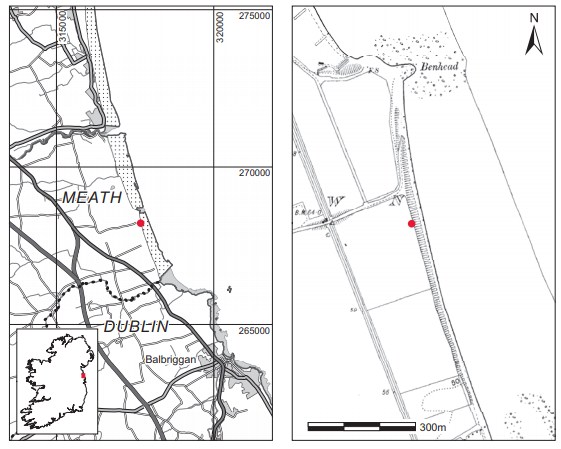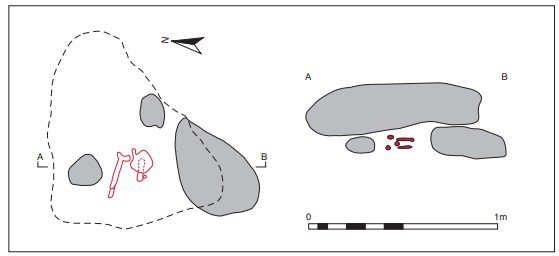County: Meath Site name: IRISHTOWN, CO. MEATH
Sites and Monuments Record No.: SMR ME028-018 Licence number: E1136
Author: PETER DANAHER
Site type: Graves of indeterminate date
Period/Dating: —
ITM: E 717612m, N 768236m
Latitude, Longitude (decimal degrees): 53.650669, -6.220916
Introduction
In June 1964 a human skull and some bones were found lying on a beach at Irishtown, Co. Meath. The bones were discovered by Ronald Musgrave of North Circular Road in Dublin, who reported the find to the NMI. A rescue excavation was carried out the following day (13 June) by Peter Danaher. The human remains were examined by Professor C.A. Erskine. This report is based on Danaher’s excavation report and on Erskine’s analysis of the bones.
Location (Fig. 6.41)
The site was in the townland of Irishtown, east Co. Meath.73 The burial was located on a cliff face overlooking a beach. Part of the cliff face along this stretch of beach seemed to have subsided at some period, producing the ledge on which the grave was sited.
Description of site
The grave was roughly constructed. A hole had been dug on a ledge of the cliff face, the body inserted and a few large tufa-like boulders thrown on top for protection. There was no attempt at formal walling of the grave but it was covered by a large capstone that rested on two boulders (Fig. 6.42). The grave had been dug into a brown, stony, humified layer, 0.35m thick, which overlay a greyish-brown gravelly and humified layer, 0.75m thick, which in turn overlay a pebble storm beach, over 1m thick, at the foot of the cliff. Immediately over the brown, stony humified layer into which the grave had been dug was a layer of very fine silt some of which, mixed with small stones, was found among the bones in the grave. The capstone was approximately triangular in shape and measured 1.1m by 0.9m by 0.28m at the maximum.


The grave contained an inhumation (1964:59) with no accompanying artefacts. The pelvis and parts of the femora were still in situ at the time of excavation, and these were located immediately above the skull and other bones which had been found on the previous day. The location of these bones indicated that the body had been buried in a crouched position, with the head to the east. No other details were noted as to the position of the arms etc. Three undiagnostic glazed potsherds of medieval type were found about 0.6m from the bones and at the same depth in the brown, stony humified layer.74 These potsherds were not found together and were not associated with the skeleton.
Comment
The human remains from this site have not been dated and in the absence of associated gravegoods it is not possible to date it with certainty. The disposition of the remains in the ground suggests that the body was in a crouched position. This usually indicates a burial of prehistoric date but whether Neolithic, Bronze Age or Iron Age is not known. The form of the grave is less structured than might be expected of a Neolithic or Bronze Age cist. It is unusual for burials of these periods to have stones lying on top of the skeleton as well as having a capstone. The unstructured walls and the stones on the skeleton are perhaps more indicative of an Iron Age burial. The coastline of County Meath is c. 10km long, and along this short stretch there are several Neolithic monuments as well as Bronze Age and Iron Age burial sites recorded, including an undated pit burial of a crouched inhumation at Mosney75 (this volume, pp 405–6). In recent years an extensive cemetery of early medieval date was discovered during test trenching and excavation at Betaghstown (Eogan 2009). Although most of the burials were extended supine inhumations, there were some variations, including slight flexing, a crouched female inhumation and a male with his legs drawn up over the left side of the abdomen, demonstrating that there can be some differences in rite within the same burial area during the early medieval period. It is not known whether this reflects different phases of use at the site or differences in ritual.
HUMAN REMAINS
C.A. ERSKINE
Bones (1964:59) from one individual of middle age. Consist of 20–25 large fragments and a few small pieces. Mainly of skull, lumbar vertebrae, innominate bones and sacrum and the upper three-quarters of two femora. All are in good condition. Notable absence of parts of cervical and thoracic vertebrae, hand and foot bones, ribs and long bones of arm.
Sex: male on basis of femora and especially pelvic bones—narrow sciatic notch, sacroiliac region and iliac fossa of male type. Sacrum: pieces can be fitted and it is typically male. Segments well united. Anterior sacral foramina smaller than normal (not significant).
Skull: frontal bones and upper parts of parietals noticeably flattened, though not abnormally so. Supraorbital ridges marked and frontal sinuses well developed. Pitting on inside of frontal bones noticeable. Post-mortem crack along suture one between frontal and right parietal. Mandible: moderate size, somewhat shallow, which suggests age; most of teeth present (recent post-mortem loss of incisors), marked wear, though molars in good condition.
Peculiarities: interesting feature in collection is the condition of the right femur. This shows an ante-mortem fracture in the middle third; the two fragments were separated but can be fitted closely and union had taken place during life. The fracture probably occurred one to several years before death. Fragments were malunited and there is considerable angulation with outgrowths of bone (exostoses) at the fracture margins. Well-developed cancellous tissue in marrow cavity. Partial cortical bone incurving in part of margin suggests possibility of some degree of movement of fragments some time before eventual union.
73. Parish of Moorechurch, barony of Duleek Upper. SMR ME028-018——. IGR 317687 268218 .
74. 1964:60–62. Three miscellaneous potsherds of medieval date. Thin, well-fired fabric with sandy grits. Orange surfaces, with a greyish core. Outer surface of each bears a greenish glaze. Outer surface on one of the sherds is decorated with parallel grooves. The sherds show signs of having been wheel-turned. Maximum length, width and thickness of the largest: 3.4cm x 2.4cm x 7mm. Maximum length, width and thickness of the smallest: 2.6cm x 1.7cm x 6mm.
75. See Archaeological inventory of County Meath (Moore 1987), sites nos 24, 25 (Gormanstown), 280 (Irishtown), 286 (Mosney), 268 (Briarleas), 204 (Ninch), 267, 1594 (Betaghstown) and map no. 14. These sites are listed from south to north.